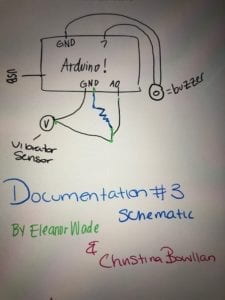Sensor experimenting: Vibration sensor
learning to use and experiment with this sensor was very helpful to my understanding of this class a and how to work with interactive devices overall. particularly because we were able to use analog inputs to change the outputs of the circuit we made, this exercise was very interesting.

First we connected the buzzer to ensure that this was working before we started using the sensor. Then we built the circuit with the intention of touching the sensor and having the buzzer make a sound. We used this websites code to make a small change to the example:
https://programmingelectronics.com/an-easy-way-to-make-noise-with-arduino-using-tone/
When this was successful right away we decided to further program and alter the code to make the circuit use the input of the sensor to change the tonal sounds of the buzzer. This was far less intuitive and we did have help, however ultimately it was very successful and interesting to hear the different sounds that could be produced.
Question 1:
In this recitation we used a vibration sensor and a buzzer. We created a circuit that sensed the vibrations when you tapped the device and then translated that into the buzzer making a sound. What made this interesting is that depending on the way in which you touched the sensor the buzzer produced a different range of tonal sounds.
This could be used in real life if for example we wanted to be able to convey more with our car horns. Rather than simply hitting the steering wheel and a honk is sounded, it would be cool if the ways in which you hit the horn could convey different sounds that could be associated with different meanings. This could be helpful for driving safety and improving communication among drivers.
Question 2:
I think this analogy makes sense because the code is what is used to explain the very most basic instructions from the computer to the Arduino. Similar to a recipe or tutorial, code is stripped down to the most essential pieces of relevant information to reproduce another outcome. In the case of experimenting and using code we found online, this very much applies in that we used only a small portion and changed the rest that did not apply to what we were doing. This is also frequently true in recipes or tutorials.
Question 3:
Computers influence human behaviors in that considering we now live in a world where it is impossible to separate ourselves from technology, we must constantly interact with this aspect of the world. In Language of New Media, Manovich gives numerous examples and explanations for the ways in which we are influenced by computers. What is particularly compelling about this article is the way in which it incorporates a historical perspective on technological advances and how that has been meaningful to human life.
good job Eleanor!
I’m just missing your code. For the next posts please copy and paste it here or you can post a link to your code on github if you have an account there: https://github.com/